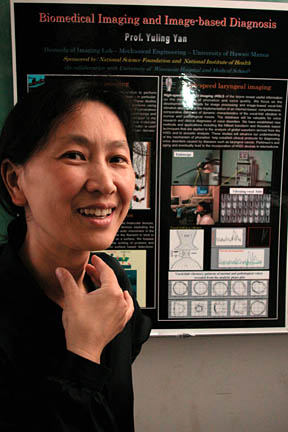
Yuling Yan, a biomedical engineer at the University of Hawaii, developed a patented technique to explain the characteristics of vocal patterns.
Tool detects vocal
abnormalitiesA UH researcher develops a method
to interpret images of vocal cord
vibrations
Observing vibrations in mechanical systems to see if they behaved normally led a University of Hawaii biomedical engineer to develop a method of diagnosing voice disorders.
A very sensitive vibration in the mechanics would indicate a problem, said Yuling Yan, then at the University of Wisconsin-Madison, and certain characteristics of the signals revealed whether they were normal or abnormal.
Talking to UW medical researcher Diane Bless, who works on voice problems, they realized the way the vocal cord vibrates is similar to mechanical vibrations, Yan said.
"It got me really interested, so we started looking at (laryngeal) images she had and tried to figure out what is normal and what is the difference."
Yan said they can get 2,000 images a second of a person's larynx (voice box) with a high-speed digital imaging device but the system hasn't been widely used because there was no way to interpret the images.
"Now, we have a tool, a very successful one," she said.
Working with Bless, Yan developed a method and software to explain characteristics of the vocal patterns. So far, she said, her diagnosis is "very accurate. We can distinguish normal and abnormal for sure."
Yan joined the UH-Manoa department of mechanical engineering as an assistant professor two years ago and patented her technique. It was her third patent.
She said there has been interest from Europe on the system for early detection of Parkinson's disease.
Yan invited Bless to give a seminar last year at Tripler Army Medical Center, and she said doctors were so impressed they ordered a high-speed digital processing system, which is expected to arrive this week.
The only female professor in the UH mechanical engineering department, Yan recently received a three-year, $321,475 peer-reviewed National Science Foundation grant for her biomedical research program.
Yan is working with Bless and Dr. Michael Holtel at Tripler to develop a database of vocal health condition characteristics for online diagnosis of voice patterns and medical training.
"Eventually, we hope the whole thing -- examination and analysis -- can be done online in real time through a telemedicine program," she said.
Tripler doctors will send laryngeal images of patients to Yan for analysis after they begin using the imaging system.
Holtel, a navy captain and ear, nose and throat specialist, said many patients have voice problems, such as difficulty speaking or a hoarse voice, "sometimes to the point of not making themselves heard."
Holtel said Tripler's new imaging system is the first of its kind in Hawaii and even most major medical centers don't have it yet. Tripler's speech pathologists will be doing a lot of work with it, he said.
"Basically, it's high-speed photography," he said. "It allows you to see the way vocal cords move, because they move fairly fast. In a sense, you kind of slow that down and it delivers information on how vocal cords move that we don't currently get with any other instruments."
The doctors hope additional information provided by Yan's system will enable them to detect and better define abnormalities and treat patients more effectively, he said.
Yan said her analytical technique and software can be used not only for diagnosis but to evaluate the effectiveness of voice treatment, therapy or surgery.
"When we talk, our vocal cords are vibrating, so the dynamics of the vocal cord or laryngeal system affect quality when people talk," she explained.
If the larynx has a polyp or disease or becomes stiff from aging, it will change the biomechanical properties of the vocal cord and voice quality, she said.
Patients with normal voices have different cycles of vibrations than those with a cyst or other disorders, she found. Those with a normal voice can sustain the pattern but it changes for those with a medical problem, she said.
"Understanding of the mechanics, how the voice is produced and how it is affected by all those biomedical parameters and other factors, we can help diagnose or prediagnose a voice problem, including some neurological disorders caused by Parkinson's, for example, and laryngeal cancer," she said.
There may be no clues on the surface of the larynx, but the dynamics of the voice quality through laryngeal imaging might indicate something is wrong at a very early stage, she said.
Voice care and therapy also are of great interest for professional and cosmetic reasons, she pointed out, noting a recent Associated Press article on CNN.com about growing requests for "cosmetic surgery" for the voice.
"There are people who pay $15,000 for a face-lift and as soon as they open their mouth, they sound like they're 75," Dr. Robert Thayer Sataloff of Graduate Hospital in Philadelphia said in the report.
